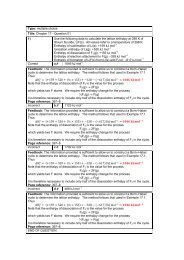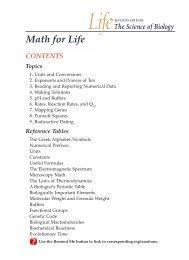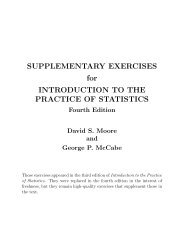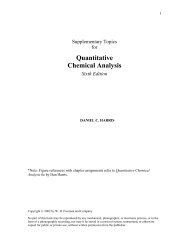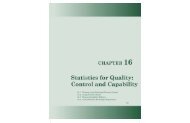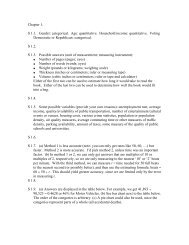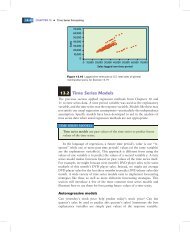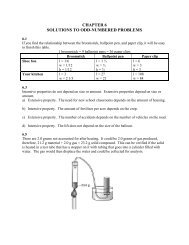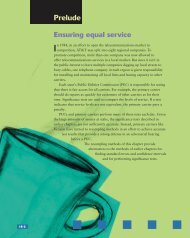Chapter 3 - Experimental Error - WH Freeman
Chapter 3 - Experimental Error - WH Freeman
Chapter 3 - Experimental Error - WH Freeman
You also want an ePaper? Increase the reach of your titles
YUMPU automatically turns print PDFs into web optimized ePapers that Google loves.
50 3 <strong>Experimental</strong> <strong>Error</strong><br />
Box 3-1<br />
Standard Reference Materials<br />
Inaccurate laboratory measurements can mean wrong medical<br />
Before introduction of this reference material, five labo-<br />
diagnosis and treatment, lost production time, wasted Retracked ratories gain analyzing 1 line identical samples reported a range of<br />
energy and materials, manufacturing rejects, and product liability<br />
problems. To minimize errors in laboratory measurements,<br />
the U.S. National Institute of Standards and Technology<br />
results with relative errors of 40 to 110% of the expected<br />
value. After distribution of the reference material, the error<br />
was reduced to 20 to 40%.<br />
distributes more than 1 000 Standard Reference Materials,<br />
such as metals, chemicals, rubber, plastics, engineering<br />
materials, radioactive substances, and environmental and<br />
clinical standards that can be used to test the accuracy of<br />
analytical procedures used in different laboratories. 1<br />
For example, in treating patients with epilepsy, physicians<br />
depend on laboratory tests to measure concentrations of<br />
anticonvulsant drugs in blood serum. Drug levels that are too<br />
low lead to seizures; high levels are toxic. Because tests of<br />
identical serum specimens at different laboratories were giving<br />
an unacceptably wide range of results, the National Institute<br />
of Standards and Technology developed a Standard Reference<br />
Material containing known levels of antiepilepsy drugs<br />
120<br />
100<br />
80<br />
60<br />
40<br />
20<br />
Before<br />
After<br />
0<br />
in serum. The reference material now enables different laboratories<br />
to detect and correct errors in their assay procedures.<br />
Phenytoin Phenobarbital<br />
<strong>Error</strong> (% of target value)<br />
Primidone<br />
(Mysoline)<br />
Ethosuximide<br />
(Zarontin)<br />
Ways to detect systematic error:<br />
1. Analyze samples of known composition,<br />
such as a Standard Reference<br />
Material. Your method should reproduce<br />
the known answer. (See Box<br />
15-1 for an example.)<br />
2. Analyze “blank” samples containing<br />
none of the analyte being sought. If<br />
you observe a nonzero result, your<br />
method responds to more than you<br />
intend. Section 29-3 discusses different<br />
kinds of blanks.<br />
3. Use different analytical methods to<br />
measure the same quantity. If the<br />
results do not agree, there is error in<br />
one (or more) of the methods.<br />
4. Round robin experiment: Assign different<br />
people in several laboratories<br />
to analyze identical samples by the<br />
same or different methods.<br />
Disagreement beyond the estimated<br />
random error is systematic error.<br />
Random error cannot be eliminated, but<br />
it might be reduced by a better<br />
experiment.<br />
For example, using a pH meter that has been standardized incorrectly produces<br />
a systematic error. Suppose you think that the pH of the buffer used to standardize<br />
the meter is 7.00, but it is really 7.08. Then all your pH readings will be 0.08 pH<br />
unit too low. When you read a pH of 5.60, the actual pH of the sample is 5.68. This<br />
systematic error could be discovered by using a second buffer of known pH to test<br />
the meter.<br />
Another systematic error arises when you use an uncalibrated buret. The manufacturer’s<br />
tolerance for a Class A 50-mL buret is 0.05 mL. When you think you have<br />
delivered 29.43 mL, the real volume could be anywhere from 29.38 to 29.48 mL and<br />
still be within tolerance. One way to correct for an error of this type is to construct a<br />
calibration curve, such as that in Figure 3-3, by the procedure on page 44. To do this,<br />
deliver distilled water from the buret into a flask and weigh it. Determine the volume<br />
of water from its mass by using Table 2-7. Figure 3-3 tells us to apply a correction factor<br />
of 0.03 mL to the measured value of 29.43 mL. The actual volume delivered is<br />
29.43 0.03 29.40 mL.<br />
A key feature of systematic error is that it is reproducible. For the buret just discussed,<br />
the error is always 0.03 mL when the buret reading is 29.43 mL. Systematic<br />
error may always be positive in some regions and always negative in others. With care<br />
and cleverness, you can detect and correct a systematic error.<br />
Random <strong>Error</strong><br />
Random error, also called indeterminate error, arises from the effects of uncontrolled<br />
(and maybe uncontrollable) variables in the measurement. Random error has an<br />
equal chance of being positive or negative. It is always present and cannot be corrected.<br />
There is random error associated with reading a scale. Different people reading the<br />
scale in Figure 3-1 report a range of values representing their subjective interpolation<br />
between the markings. One person reading the same instrument several times might





